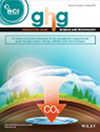Enhanced sintering resistance of NiFe-based RWGS catalysts through Cu doping
Jiayi Wu, Wenhao Zhang, Hecao Chen, Weifeng Yu, Bo Sun, Minghui Zhu, Yi-Fan Han
求助PDF
{"title":"Enhanced sintering resistance of NiFe-based RWGS catalysts through Cu doping","authors":"Jiayi Wu, Wenhao Zhang, Hecao Chen, Weifeng Yu, Bo Sun, Minghui Zhu, Yi-Fan Han","doi":"10.1002/ghg.2314","DOIUrl":null,"url":null,"abstract":"<p>The reverse water-gas shift (RWGS) reaction offers an effective method for mitigating CO<sub>2</sub> emissions. Due to its affordability and physicochemical stability, iron has garnered significant attention as a potential catalyst for RWGS. The incorporation of nickel and copper promoters can enhance CO<sub>2</sub> conversion and CO selectivity in Fe-based catalysts. This study focuses on modifying the strength of the Strong Metal-Support Interaction (SMSI) through particle size optimization. Doping Cu into NiFe-based catalysts restricts particle size, which influences the curvature of the Ni<sup>0</sup>@FeO<sub>x</sub> interface. This curvature enhances the electron coupling between Ni<sup>0</sup> and FeO<sub>x</sub>, promoting the formation of a denser and thicker Ni<sup>0</sup> and FeO<sub>x</sub> layer. This results in a nearly 90% increase in the CO<sub>2</sub> reaction rate during the sintering resistance test by anchoring Ni<sup>0</sup> and facilitating electron transfer to active sites. Such morphological evolution improves high-temperature resistance to sintering during RWGS. © 2024 Society of Chemical Industry and John Wiley & Sons, Ltd.</p>","PeriodicalId":12796,"journal":{"name":"Greenhouse Gases: Science and Technology","volume":"14 6","pages":"1113-1121"},"PeriodicalIF":2.7000,"publicationDate":"2024-11-19","publicationTypes":"Journal Article","fieldsOfStudy":null,"isOpenAccess":false,"openAccessPdf":"","citationCount":"0","resultStr":null,"platform":"Semanticscholar","paperid":null,"PeriodicalName":"Greenhouse Gases: Science and Technology","FirstCategoryId":"93","ListUrlMain":"https://onlinelibrary.wiley.com/doi/10.1002/ghg.2314","RegionNum":4,"RegionCategory":"环境科学与生态学","ArticlePicture":[],"TitleCN":null,"AbstractTextCN":null,"PMCID":null,"EPubDate":"","PubModel":"","JCR":"Q3","JCRName":"ENERGY & FUELS","Score":null,"Total":0}
引用次数: 0
引用
批量引用
Abstract
The reverse water-gas shift (RWGS) reaction offers an effective method for mitigating CO2 emissions. Due to its affordability and physicochemical stability, iron has garnered significant attention as a potential catalyst for RWGS. The incorporation of nickel and copper promoters can enhance CO2 conversion and CO selectivity in Fe-based catalysts. This study focuses on modifying the strength of the Strong Metal-Support Interaction (SMSI) through particle size optimization. Doping Cu into NiFe-based catalysts restricts particle size, which influences the curvature of the Ni0 @FeOx interface. This curvature enhances the electron coupling between Ni0 and FeOx , promoting the formation of a denser and thicker Ni0 and FeOx layer. This results in a nearly 90% increase in the CO2 reaction rate during the sintering resistance test by anchoring Ni0 and facilitating electron transfer to active sites. Such morphological evolution improves high-temperature resistance to sintering during RWGS. © 2024 Society of Chemical Industry and John Wiley & Sons, Ltd.
通过掺杂铜提高 NiFe 基 RWGS 催化剂的抗烧结性
逆向水气转换(RWGS)反应为减少二氧化碳排放提供了一种有效的方法。由于其可负担性和物理化学稳定性,铁作为RWGS的潜在催化剂受到了广泛关注。在铁基催化剂中加入镍和铜促进剂可以提高CO的选择性和CO的转化率。本研究的重点是通过粒度优化来改变强金属-载体相互作用(SMSI)的强度。在nife基催化剂中掺杂Cu会限制催化剂的粒径,从而影响Ni0@FeOx界面的曲率。这种曲率增强了Ni0和FeOx之间的电子耦合,促进了Ni0和FeOx层的致密和厚度的形成。通过锚定Ni0和促进电子转移到活性位点,在抗烧结测试中,二氧化碳反应速率提高了近90%。这种形态的演变提高了RWGS过程中的高温烧结性能。©2024化学工业协会和John Wiley &;儿子,有限公司
本文章由计算机程序翻译,如有差异,请以英文原文为准。


